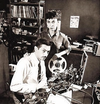

Contributor Max Alper covers the background, work, and influence of Louis + Bebe Barron, the pioneers of avant-garde music and sound design in Hollywood.
Before the proliferation of the synthesizer as an essential tool for any recording studio or music technologist, magnetic tape was the primary medium for the creation of 20th century electronic music. While composers such as Halim El-Dabh, Pierre Schaeffer, and Pierre Henry were some of the first to recognize the potential of this new recording technology as a vehicle for the creation of avant-garde music, others sought a new venue for magnetic tape sounds beyond the stuffy concert hall: the film industry. Enter Louis and Bebe Barron.

(Source)
Both Louis and Bebe received undergraduate music degrees, while Louis also had an interest in electrical engineering as a hobby. It was only after their wedding in 1947 however, where they received a tape recorder as a gift, did the duo decide to combine their collective knowledge of music and electronics to create a studio for-hire in their tiny Greenwich Village apartment. While Louis focused his energy creating new sonic circuitries, such as tape delays, oscillators, and tube overdrives, Bebe would apply her skills as a classically trained pianist for in-studio performance and recorded compositions using these homemade devices. As composer Jane Brockman describes it after her 1992 interview with Bebe:
“The electric circuits were… well, circuits. And their sounds originated as dirty noise – it was Bebe, who developed the ability to know which sounds could be made into something musically useful.”
The Barrons’ work initially got them hired as technicians for John Cage’s 1953 massive tape collage Williams Mix, a piece that took over two years to painstakingly cut and paste together. While their skills in the studio were clearly appreciated by the New York avant-garde, the Barrons were unable to pay their bills through concert music projects. It was through this financial predicament that they decided to turn their attention to designing tape music for film.
In 1956, the Barrons would create the original score and sound designs for the Oscar-nominated science fiction film Forbidden Planet. And while their sounds would add to the critical praise of the film at the time, the American Federation of Musicians would not only prevent the Academy from nominating the Barrons for the Best Original Score category, but would prevent the producers of the film from even referring to it as music. As the credits roll at the end of Forbidden Planet, “electronic tonalities” is prefaced before Louis and Bebe’s names scroll down.

(Source)
When the Academy nominated the film for Best Special Effects, they mentioned only the visual FX artists and left the Barrons out, as Best Sound Design did not become its own award category until 1963. Louis and Bebe Barron, the pioneers of avant-garde music and sound design in Hollywood that were snubbed by their own musical colleagues, would never score another film. And yet considering the role avant-garde electronic music plays in film scoring today, the Barrons’ work in Forbidden Planet proved and solidified the need for forward thinking sonic artists in even the most commercial of film projects. New sounds will always bring new sights to life.

